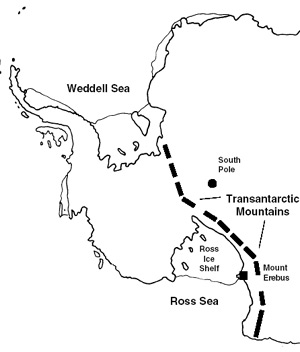
| Glasgow Digital Library | Voyage of the Scotia | BRUCE | PEOPLE | SHIP | ANTARCTIC | INDEX |
|---|

James Clark Ross was the nephew of the Arctic explorer (from Stranraer) Sir John Ross. James had sailed with his uncle to the Arctic when efforts were being made to find the Northwest Passage, the route between Canada and the Arctic ice. The last port of call before the Antarctic for Ross was Hobart in Tasmania. One of his objectives was to find the South Magnetic Pole, as on his Arctic voyage he had found the North Magnetic Pole. He found the sea fairly open and made a thorough exploration of this area, finding the charts made by the American Wilkes to be extremely inaccurate with some land areas actually sea.
The Ross expedition in 1839-1843 used two admiralty 'bomb' vessels, Erebus and Terror. These were very strong craft, having been used to fire 'bombs', or heavy mortars.
Ross explored the area now known as the Ross Sea and the Ross Ice Shelf (which he described as a barrier 200 feet high and stretching for hundreds of miles). He was the first to discover the Transantarctic Mountains and two volcanoes - which he called Erebus (which was active) and Terror after his ships.
After the Ross Expedition there were no major expeditions to the Antarctic for 30 years.
Arctic and Antarctic
Many Antarctic explorers had served time in Arctic waters and both James Ross and his uncle John were on the first Franklin expedition searching for the Northwest Passage. When Ross returned from the Antarctic he was offered a leading part in the second Franklin expedition but declined. Erebus and Terror (now fitted with steam locomotive engines) sailed on a voyage toward the Northwest Passage and were never seen again. James Ross led a fleet of 15 ships and 500 men on a search for Franklin. Sir John Ross also took part in this search, in the Ayr-built Felix.
| Glasgow Digital Library | Voyage of the Scotia | BRUCE | PEOPLE | SHIP | ANTARCTIC | INDEX |
|---|